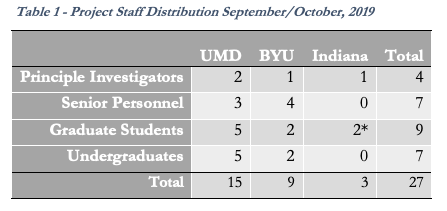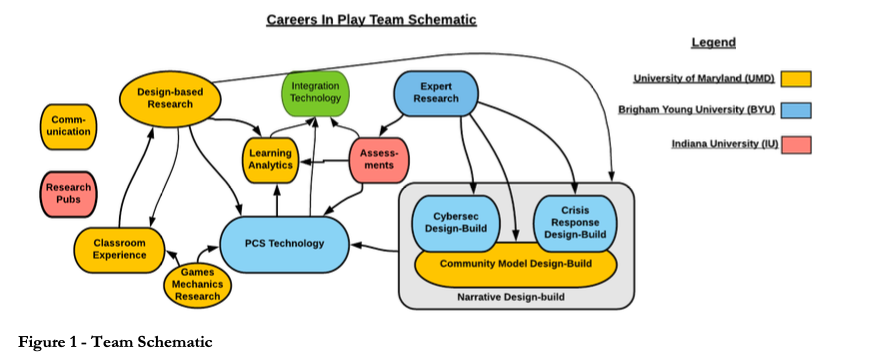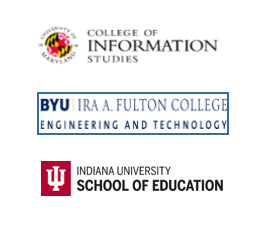Project Progress
In the almost two months since the project kickoff on July 19, the institutions involved in this project have focused on goals, recruiting, and organization. As of now, the project has over 25 staff members across the three collaborating institutions. One of the challenges of this project is the distribution of expertise and budget across the three sites. This team gives is a rich group to draw on for the work, but also coordination challenges to be addressed. In addition, many of the people who are subject matter experts are budgeted for only a semester or two, which raises the importance of effective communication and efficiency in our organizational structure.

Many Overlapping Small Teams—Inspired by Agile Software Approaches
In developing an organizational approach for this project, we have some important considerations. Every single project team member in the research institutions has other commitments each week—classes, other research meetings, and administrative events—that generally cannot be moved. Getting a large number of people available for any meeting is a difficulty further complicated by geography and time zones. Rather than a core team of a few people allocating a significant portion of their time to the project, many faculty and staff have a small portion of their time and we need to be efficient in how we use their expertise. In addition, several team members have important experience with prior work that this project is leveraging so utilizing and sharing that expertise is essential.

Team Descriptions
The approach that was developed to maximize talent and minimize logistics involves many small teams with overlapping members who are responsible for information sharing. Figure 1 is a conceptual schematic of the team structure with arrows indicating both knowledge sharing and joint membership. By keeping team membership no more than seven we can more easily coordinate meeting and tasks. By having people who span multiple teams we can keep the teams synchronized. The expert research team, for example, will provide information to the team that is designing and building the narrative structures as well as the design of the assessments. In this approach, each team has a “center of gravity” in one institution while commonly having members from other institutions. The Expert Research team, for example is led at BYU, but includes a PI and a student from Maryland.
The thirteen teams are located across three partner institutions. The teams focus on different aspects of the project with members contributing across teams. The work is done on an as-needed basis, hence, there are times when all the teams will be or will not be active, or some make early and short contributions with others operating for a longer period.
- Expert Research. This team is conducting semi-structured interviews with cybersecurity experts to understand the kinds of scenarios that are plausible in cybersecurity work. The information this team collects will help inform the design of the game narrative. Jon Balzotti (BYU) and Beth Bonsignore (UMD) co-lead this group that should complete these interviews in November with another round of interviews for disaster response to occur later in the project at a time not yet scheduled.
- Other Games Research. This team is collecting information on game mechanics which will be useful in the overall project design. It became active in fall, 2019 and will complete much of its work later in the semester when its members join other teams. It is led by Phil Piety and Beth Bonsignore.
- Classroom Experience Design. This team is responsible for understanding the classroom contexts that the PCS interventions will operate in. Because this project proposed studying in live undergraduate classes, careful work needs to be done to ensure a smooth integration into the work instructors are doing. This team is beginning in the fall 2019 semester and will become important at validating potential design options. An important goal of this team is making sure teachers are prepared to use the project’s work for graded assignments. This team is jointly led by Phil Piety, Kate Iszac, and Jason McDonald.
- Community Model Design/Authoring. This team will be responsible for the development of a fictional universe where both the cybersecurity and disaster response narratives can operate. In the past, PCS narratives were integrated consisting of both the fictional characters and the sequence or events or story beats. In this version of the PCS, the two curriculum narratives with share a common fictional community, although will be used in different classes. This team should begin its work near the end of the year and more fully in 2020.
- Cybersecurity Narrative. This team will develop the scenario for the cybersecurity version of the Careers In Play PCS. This is the essential first PCS testing the role-based collaborative design. It is led by Jon Balzotti with support from Susan Campbell (UMD). This team will begin work in late 2019 and more fully in 2020. It will coordinate with the Community Model Design/Authoring team.
- Disaster Response Narrative. This team will work under the joint leadership of Amanda Hughes (BYU) and Kate Izsak (UMD) will design the upcoming crisis response course. This team will begin in mid-2020 for a 2021 pilot of this PCS version.
- Playable Case Studies (PCS) Technology Enhancement. This team is led by Derek Hansen (BYU) and the team is updating PCS technology to support both inter and intra project collaborations. This team has been working since the beginning of the fall 2019 semester and will continue into 2020 and throughout the project as needed.
- Design-Based Research (DBR). This team is jointly led by Beth Bonsignore and Jason McDonald. While the design involves a number of parts from the project from the event sequences to the fictional world to the components that go into a classroom such as assignments and alternate material, the DBR team will be responsible for the process and for the collection and management of research data from co-design sessions and classroom enactment. This team will have at least one member from every team that is doing some element of design. This team begins its work in late 2019 and will continue for the remainder of the project.
- Project Communication. This team is led by Phil Piety at UMD where the team develops the web sites for both the project and the learning analytic components that will be an open sourced software (OSS) project as well as and other communication tools for the project such as poster and presentation templates when needed.
- Learning Analytics Design/Build. This team designing the learning analytics database system for the project as well as the OSS version. It is led by Phil Piety and has been at work since fall 2019 and will continue through the project.
- The Integration Technology team will be jointly led by Phil Piety and Derek Hansen. This team will become active in 2020 to develop a common data exchange framework for the project.
- The Assessments team will be developing measures that are to be used in PCS and classrooms It will be led by Dan Hickey (Indiana) with support from Phil Piety. This team will become active in late 2019, early 2020.
- The Research Publications team is largely run by graduate students with Indiana doctoral student Grant Chartrand in a coordinating role. This team became active in the fall of 2019 beginning with some literature reviews. This is a support team that will help authors of papers and other work to make sense of the literature in the fields related to this project.
Using an Agile Approach
The approach for managing the work of the different teams involves two-basic levels: teams and PIs. The team-based management draws off of the agile principles of self-organizing teams. Each team develops a way for tracking the work they are doing in a way that makes the most sense for them. Most teams are using a task-board kind of process where there is a public display of tasks and who has completed what. This is a common approach with software development projects. Team meetings often begin with a review of these issues and an updating of the task board. While some agile teams have a daily meeting, that structure is not practical for this project so most teams meet weekly and members will work outside of those meetings and use the team meeting for status updates and to synchronize. The standard technology for the status boards is the Trello product that is free for this scale of use. Figure 2 shows the Trello board for the other games research team.

The second level of coordination is the weekly PI meeting where PIs joined by some others as needed will discuss the project direction, challenges, and the progress each team has made. In this way there is an accounting of progress and also an opportunity for PIs who are part of all of the various teams to be informed of developments that relate to them.
Careers In Play Leadership Team
Phil Piety, PhD. University of Maryland iSchool (PI and Learning Analytics). ppiety@umd.edu
Beth Bonsignore PhD. University of Maryland iSchool (Co-PI and Design-based Research), ebonsign@umd.edu
Derek Hansen, PhD.Brigham Young University (Co-PI and Game Technology). dlhansen@byu.edu
Dan Hickey, PhD. Indiana University School of Education (Co-PI, Learning Theory and Assessments). dthickey@umd.edu
